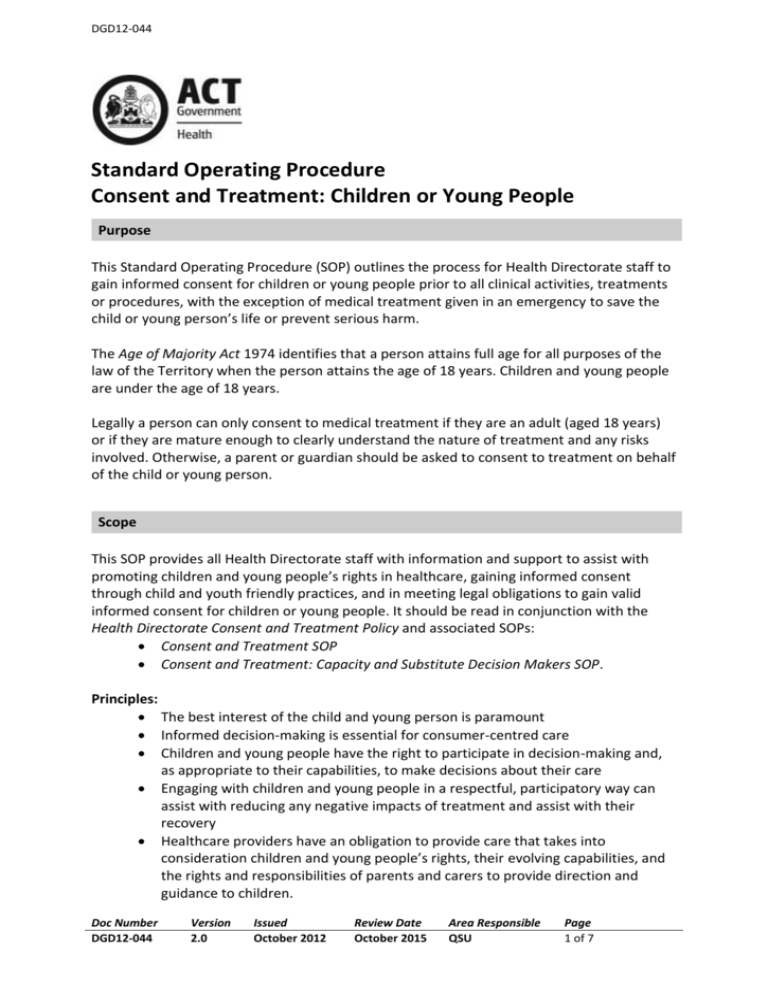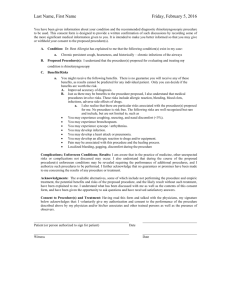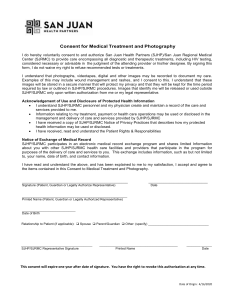Consent For a Child or Young Person SOP
advertisement

DGD12-044 Standard Operating Procedure Consent and Treatment: Children or Young People Purpose This Standard Operating Procedure (SOP) outlines the process for Health Directorate staff to gain informed consent for children or young people prior to all clinical activities, treatments or procedures, with the exception of medical treatment given in an emergency to save the child or young person’s life or prevent serious harm. The Age of Majority Act 1974 identifies that a person attains full age for all purposes of the law of the Territory when the person attains the age of 18 years. Children and young people are under the age of 18 years. Legally a person can only consent to medical treatment if they are an adult (aged 18 years) or if they are mature enough to clearly understand the nature of treatment and any risks involved. Otherwise, a parent or guardian should be asked to consent to treatment on behalf of the child or young person. Scope This SOP provides all Health Directorate staff with information and support to assist with promoting children and young people’s rights in healthcare, gaining informed consent through child and youth friendly practices, and in meeting legal obligations to gain valid informed consent for children or young people. It should be read in conjunction with the Health Directorate Consent and Treatment Policy and associated SOPs: Consent and Treatment SOP Consent and Treatment: Capacity and Substitute Decision Makers SOP. Principles: The best interest of the child and young person is paramount Informed decision-making is essential for consumer-centred care Children and young people have the right to participate in decision-making and, as appropriate to their capabilities, to make decisions about their care Engaging with children and young people in a respectful, participatory way can assist with reducing any negative impacts of treatment and assist with their recovery Healthcare providers have an obligation to provide care that takes into consideration children and young people’s rights, their evolving capabilities, and the rights and responsibilities of parents and carers to provide direction and guidance to children. Doc Number DGD12-044 Version 2.0 Issued October 2012 Review Date October 2015 Area Responsible QSU Page 1 of 7 DGD12-044 Procedure 1. Consent in a medical emergency 1.1 In the event of a medical emergency relating to a child or young person, parental consent is not required if the treating medical officer believes that immediate action is necessary to resolve the medical emergency. 2. Consent by the child or young person – Mature young person consent 2.1 It is not necessary to seek a parent or guardian’s consent if a medical officer assesses the child or young person has the sufficient intelligence, maturity and understanding to comprehend the nature of the treatment and the implications of the treatment or procedure. Tools such as the Gillett principles should be used. In this situation, a child or young person may give consent for their own medical care. 2.2 The obligation of the medical officer when obtaining mature young person consent is to: Document all action taken to establish decision-making capacity for consent, all questions asked and answers given, and Ask another medical officer to assess the mature young person and provide and document their opinion regarding decision-making capacity for consent. Refer to Health Directorate Consent: Capacity and Substitute Decision Makers. 3. Consent by people with parental responsibility 3.1 Generally, parents have the primary responsibility for providing consent for the child or young person. 3.2 If two or more people have parental responsibility for the child or young person, each of them may act alone in discharging their responsibility. 3.3 An informal carer (acting in place of a parent, e.g. a family friend) may not legally consent to medical treatment on behalf of a child or young person. 3.4 The Director-General of Community Services Directorate, Office for Children, Youth and Family Support may provide consent to medical, dental and similar treatment for a child or young person for whom the Director-General has parental responsibility. 4. Consent for children without parents in attendance 4.1 Where urgent medical treatment is required to save a child or young person’s life or prevent serious harm and the parents are not in attendance to provide consent, medical treatment can be given. 4.2 Where a child or young person requires treatment, that is not a medical emergency, telephone consent may be obtained from the parent or legal guardian. Another health professional must listen to the consent conversation to corroborate the information given to the parent or legal guardian and co‐sign that valid informed consent has been obtained. Doc Number DGD12-044 Version 2.0 Issued October 2012 Review Date October 2015 Area Responsible QSU Page 2 of 7 DGD12-044 4.3 If no parent or legal guardian can be contacted the matter should be escalated to the following officers before contact is made with an external agency (Refer to Item 7.3): Clinical Director of Medicine or Surgery, or Senior Health Professional Executive Director of the Division. 5. Consent by persons authorised with daily care responsibilities for children and young people 5.1 The Director-General of Community Services Directorate, Office for Children, Youth and Family Support can authorise others to exercise parental responsibilities for a particular child or young person, where the Director-General holds parental responsibility for that child or young person. The authorised person may be a carer or a family member and the authorisation may be given orally or in writing. 5.2 For any child or young person identified as placed in ‘out of home care’, Health Directorate staff must contact the Office for Children, Youth and Family Support to confirm the scope of authority of the authorised person. 5.3 For most ‘out of home care’ children or young people, the authorised person will only have daily care responsibility. In accordance with the Children & Young People Act 2008, a person with daily care responsibility for a child or young person may only consent to the following for the child or young person: a. A health care assessment of physical or mental wellbeing and have access to the assessment report b. Health care treatment (on the advice of a health professional), not including surgery (other than surgery mentioned in dot point c), and c. Dental treatment (on the advice of a dentist), including minor dental surgery. E.g. they can take a child or young person to a doctor but cannot consent to surgery. 6. Voluntary care agreements 6.1 Voluntary care agreements enable care of the child or young person to be shared between the Director-General of the Community Services Directorate and the parents. These are usually short term agreements of six months or less. In these circumstances, the Director-General may delegate daily care responsibility to an authorised carer. The authorised carer may consent to health treatment as set out in Items 5.2 and 5.3. 7. When there is disagreement or refusal in relation to a child or young person 7.1 Where there is conflict or confusion between parents, or parents and a child or young person, and/or a medical officer about the validity of the consent, the medical officer has the right to refuse to treat a child or young person. 7.2 Where the medical officer is confident that the child or young person understands the nature and consequences of the medical treatment or procedure and consents, they can proceed with the treatment or procedure after gaining consent from the child or young person and another medical officer confirms the child or young person’s decision-making capacity for consent. See Item 2: Consent by the child or young person – Mature young person consent. Doc Number DGD12-044 Version 2.0 Issued October 2012 Review Date October 2015 Area Responsible QSU Page 3 of 7 DGD12-044 7.3 In the event that consent cannot be gained from the parents, guardian or through mature young person consent, the child or young person and parents, (or adult with authority to consent) should be informed that the treatment will be withheld pending discussions with in order of priority the: Office of Children Youth and Family Support, and The courts, as a last resort. The Office of the Chief Justice of the Supreme Court ACT contact is: 02 6207 1786. When this situation arises the medical officer should ensure the following staff are made aware: Clinical Director of Medicine or Surgery Senior treating medical officer, and Executive Director of the Division. Evaluation Outcome Measures Valid informed consent is provided for children or young people wherever it is required. All forms used to document written consent are endorsed for use by the Health Directorate and comply with this policy and associated SOPs. Method Documentation of consent audits overseen by the Governance Health Service Standard Group. Related Legislation, Policies and Standards Legislation Age of Majority Act 1974 Children and Young People Act 2008 Civil Law (Wrongs) Act 2002 Guardianship and Management of Property Act 1991 Health Practitioner Regulation National Law (ACT) Act 2010 Health Records (Privacy and Access) Act 1997 Health Regulation (Maternal Health Information) Act 1998 Medical Treatment (Health Directions) Act 2006 Medicare Australia Act 2005 Mental Health (Treatment and Care) Act 1994 Powers of Attorney Act 2006 Public Advocate Act 2005 Road Transport (Alcohol and Drugs) Act 1977 Transplantation and Anatomy Act 1978 (2.2, 2.3, 2.5) Policy Doc Number DGD12-044 Version 2.0 Issued October 2012 Review Date October 2015 Area Responsible QSU Page 4 of 7 DGD12-044 Clinical Record Management Policy Clinical Record Documentation SOP Release or Sharing of Clinical Records or Personal Health Information SOP Consent and Treatment Policy Consent and Treatment SOP Consent and Treatment: Capacity and Substitute Decision Makers SOP Consumer and Carer Participation Framework Consumer Feedback Standards: Listening and Learning Patient Identification: Correct Patient, Correct Site, Correct Procedure Policy Patient Identification: Correct Patient, Correct Site, Correct Procedure Standard Operating Procedure General Practitioner – Hospital Access and sharing of Clinical Information within CHHS – policy General Practitioner – Hospital Access and sharing of Clinical Information within CHHS - SOP Standards ACHS EQuIP 5: 1.1 Consumers/patients are provided with high quality care throughout the care delivery process. 1.1.3 Consumers/patients are informed of the consent process, and they understand and provide consent for their health care. 1.6 The governing body is committed to consumer participation. 1.6.2 Consumers/patients are informed of their rights and responsibilities. 3.1.5 Documented corporate and clinical policies and procedures assist the organisation to provide quality, safe health care. National Safety and Quality Health Service (NSQHS) Standards: Governance for Safety and Quality in Health Service Organisations Partnering with Consumers Patient Identification and Procedure Matching Definition of Terms Capacity The term capacity is used in this document to mean a person is capable of: Understanding the nature and effect of decisions about consent and communicating the understanding verbally or non-verbally Freely and voluntarily making decisions about consent Communicating the decisions verbally or non-verbally, and Retaining the information, their decision and their consent. The type of assessment required to determine someone’s capacity will vary depending on the type of decision being made. Doc Number DGD12-044 Version 2.0 Issued October 2012 Review Date October 2015 Area Responsible QSU Page 5 of 7 DGD12-044 Clinical Activity Clinical activities improve, maintain or assess the health of a person in a clinical situation and may include invasive and non-invasive procedures (including those performed in settings other than the operating room). Some examples are: • Invasive - taking a specimen of blood - giving medication via an intravenous, intramuscular or subcutaneous route - inserting intravenous access, or - performing a surgical procedure, including a procedure performed in medical imaging. • Non-invasive - interventions such as evaluating, advising, planning (E.g. dietary education, physiotherapy assessment, crisis intervention, bereavement counselling, a procedure in medical imaging) and giving medication. Consumer In this document the term ‘consumer’ refers to patients, consumers and clients under the care of the Health Directorate. Health Professional There are two Acts which define ‘health professionals’: the Medical Treatment (Health Directions) Act 2006 (ACT) and the Health Practitioner Regulation National Law (ACT) Act 2010. For the purpose of this document a ‘health professional’ includes all doctors, dentists, nurses and allied health professionals engaged the Health Directorate to care for consumers. Informed consent A person gives consent based upon an appreciation and understanding of the facts and implications of an action. The person must be given the relevant information and have the capacity to understand it. Valid consent is based on the fundamental legal principle that the law protects the integrity and autonomy of the person. Consent for a procedure or treatment is valid if: The consumer has the capacity to give consent Full information on risks, benefits and alternatives has been provided and understood, with understanding demonstrated The consent is given freely, and The consent is specific to the procedure. Medical officer A conditionally registered or unconditionally registered medical practitioner employed by, or contracted to, the Health Directorate. Treatment Medical or surgical management of a consumer (including any medical or surgical procedure, operation, examination and any prophylactic, palliative or rehabilitative care) normally carried out by, or under the supervision of a Health Professional. Doc Number DGD12-044 Version 2.0 Issued October 2012 Review Date October 2015 Area Responsible QSU Page 6 of 7 DGD12-044 Treating medical officer Medical officer who is delegated responsibility for all or part of the care of a consumer. The treating medical officer may be a junior medical officer or senior medical officer and may not be the admitting senior medical officer. Young person An individual under the age of 18 years who may or may not have sufficient maturity and understanding to have capacity to make important decisions about healthcare. References Charter on the Rights of Children and Young People in Healthcare Services in Australia, 2011, Children’s Hospitals Australasia When can I? A Legal Information Handbook for Young People, 2009, Legal Aid Office ACT Informed Consent for Health Care Treatment, (1999), Office of the Public Advocate of the ACT, Australian Capital Territory Government Guidelines for Health Care Professionals Including Medical Practitioners and Dentists. (1999) Office of the Public Advocate of the ACT Australian Capital Territory Government Informed Consent for Health Care Treatment. (1999). Office of the Public Advocate of the ACT. Australian Capital Territory Government Guide to Informed Decision-making in Healthcare. (2011) Queensland Health. Queensland Government Guidelines for Medical Practitioners on Providing Information to Patients. (2004) National Health and Medical Research Council (NHMRC) (www. nhmrc.gov.au) Associated SOPs Consent and Treatment SOP Consent and Treatment: Capacity and Substitute Decision Makers SOP Disclaimer: This document has been developed by Health Directorate, specifically for its own use. Use of this document and any reliance on the information contained therein by any third party is at his or her own risk and Health Directorate assumes no responsibility whatsoever. Doc Number DGD12-044 Version 2.0 Issued October 2012 Review Date October 2015 Area Responsible QSU Page 7 of 7







